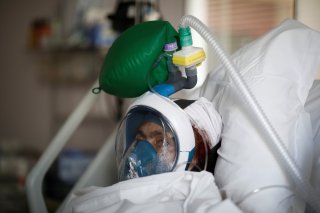America's Ventilator Crisis Is Worse Than You Can Possibly Imagine
In New York, where forty percent of coronavirus cases have been identified, is in desperate need of ventilators. But even worse than a supply shortage might be a personnel shortage. New York has only 6,800 licensed respiratory therapists, and Intensive Care Unit doctors are already managing four times their usual number of patients. Furthermore, the state only has 5,800 nurses who are critical care certified.
As the United States prepares for at least another month of social distancing measures and enforced business closures, the growth curve of the coronavirus, now with over 188,000 cases in the country, shows no signs of slowing. If the curve is not flattened, hospitals worry about how they would handle an influx of patients when their medical supplies are already dwindling.
While a majority of people who acquire coronavirus will only show flu-like symptoms or possibly be asymptomatic (but still contagious), roughly 20% of people will require hospitalization. The disease is a virus of the lungs, meaning that in severe instances it can make it difficult to breathe. Victims then require the use of a ventilator, which is a tube placed into one’s mouth, down their throat, and into their chest. Oxygen is then pumped through the tube, allowing it to circulate through the lungs, which are now unable to expel carbon monoxide on their own.
In New York, where forty percent of coronavirus cases have been identified, is in desperate need of ventilators. But even worse than a supply shortage might be a personnel shortage. New York has only 6,800 licensed respiratory therapists, and Intensive Care Unit doctors are already managing four times their usual number of patients. Furthermore, the state only has 5,800 nurses who are critical care certified.
"You can’t win a war with no troops," said Dr. Peter Papadakos, the director of critical care medicine at the University of Rochester Medical Center, to ABC News. "You can have fancy equipment, but if you don’t have any troops and if you don’t have any gasoline…you lose the war."
The idea of rationing care has led some states to provide guidelines about what patients would receive aid first. While each state is proscribing different guidelines for their hospitals, they generally favor younger people, those with fewer preexisting conditions, and those who are in less critical condition.
Some altruistic individuals are already preparing for this kind of rationing scenario. In Pittsburgh, Pennsylvania, a sixty-five-year-old woman informed her power of attorney to change her will to reflect her wish to forgo a ventilator. “I don't want to take some college student's ventilator, I don't want to take some young mother with four children's ventilator, I don't want to take a 70-year-old person's ventilator who maybe has a disabled child that they're still caring for. Age doesn't always have to be a factor with this,” said Darlene Freyer, who is a retired nurse.
“I've lived my life. I'm 65 years old. I've raised a whole family. I spoke to them about this decision. They respect this decision,” she said. “Common sense tells me our medical professionals are going to have to make some very hard decisions choosing who gets the ventilators and who does not. Why not help our warriors that are on the front line do their job just a little bit easier?"
Hunter DeRensis is a senior reporter for the National Interest. Follow him on Twitter @HunterDeRensis.

